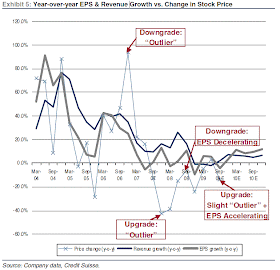Several firms are out defending Darden Restaurants (NYSE:DRI) this morning after the co beat consensus expectations in spite of worse than expected same-store sales (SSS). Stock is down over 2pts in pre market trading.
- Keybanc notes that while the 1Q proved that even DRI is not immune to the top-line pressures that plagued the casual dining industry over the June to August time frame, the firm remains optimistic that the recent quarter will represent a trough for SSS trends for both DRI and the casual dining industry. They are also encouraged by the fact that Darden managed to increase restaurant-level margins by 150 basis points year-over-year in 1Q10 despite the SSS pressures. Looking forward, the firm believes that SSS trends will sequentially stabilize and that the restaurant-level margin expansion will continue. Accordingly, they reiterate their BUY rating and $43 price target and would consider any near-term weakness in shares to represent a buying opportunity for DRI.
- JP Morgan notes that the net takeaway on Darden is that they do not think the story has changed and recommend that investors take advantage of stock declines resulting from overly optimistic trading sentiment into the release. Darden has spoiled investors with much better than industry average results. Moving forward, properly low-set sales expectations (JPM's blended comps estimate remains at down 3% vs. current guidance of down 3% to flat and previous guidance of down 2% to flat) are matched with an increased focus on costs. Darden remains a favorite in casual dining and an Analyst Focus List stock, with a $37 price target (Dec 09) representing a 14x multiple on F10 EPS estimate.
- CSFB seems to be the most cautious firm out this mroning saying EPS of $0.67 beat consensus by $0.01; however, particularly after KnappTrack improved in Aug., comp weakness at the core profit-drivers (OG and RL) was greater than feared, and guidance for the year was tweaked lower. They believe after-market weakness in the shares fairly reflects a more muted outlook at the core profit drivers, and would not be quick to buy on weakness today.
Catalysts: The call is at 8:30 AM tomorrow EDT. CSFB expects shares will open weak on the comp miss and reduced guidance. A plausible explanation behind comp deterioration into August and encouraging commentary on Sep. trends would be required to drive a more positive reaction in the shares.
Notablecalls: If you're in a mood to play bounces in this market I suggest you take a look at DRI.
Call starts at 8:30 AM.
I'm sure it can do $34.50+ if management plays their cards right.
- Keybanc notes that while the 1Q proved that even DRI is not immune to the top-line pressures that plagued the casual dining industry over the June to August time frame, the firm remains optimistic that the recent quarter will represent a trough for SSS trends for both DRI and the casual dining industry. They are also encouraged by the fact that Darden managed to increase restaurant-level margins by 150 basis points year-over-year in 1Q10 despite the SSS pressures. Looking forward, the firm believes that SSS trends will sequentially stabilize and that the restaurant-level margin expansion will continue. Accordingly, they reiterate their BUY rating and $43 price target and would consider any near-term weakness in shares to represent a buying opportunity for DRI.
- JP Morgan notes that the net takeaway on Darden is that they do not think the story has changed and recommend that investors take advantage of stock declines resulting from overly optimistic trading sentiment into the release. Darden has spoiled investors with much better than industry average results. Moving forward, properly low-set sales expectations (JPM's blended comps estimate remains at down 3% vs. current guidance of down 3% to flat and previous guidance of down 2% to flat) are matched with an increased focus on costs. Darden remains a favorite in casual dining and an Analyst Focus List stock, with a $37 price target (Dec 09) representing a 14x multiple on F10 EPS estimate.
- CSFB seems to be the most cautious firm out this mroning saying EPS of $0.67 beat consensus by $0.01; however, particularly after KnappTrack improved in Aug., comp weakness at the core profit-drivers (OG and RL) was greater than feared, and guidance for the year was tweaked lower. They believe after-market weakness in the shares fairly reflects a more muted outlook at the core profit drivers, and would not be quick to buy on weakness today.
Catalysts: The call is at 8:30 AM tomorrow EDT. CSFB expects shares will open weak on the comp miss and reduced guidance. A plausible explanation behind comp deterioration into August and encouraging commentary on Sep. trends would be required to drive a more positive reaction in the shares.
Notablecalls: If you're in a mood to play bounces in this market I suggest you take a look at DRI.
Call starts at 8:30 AM.
I'm sure it can do $34.50+ if management plays their cards right.

















